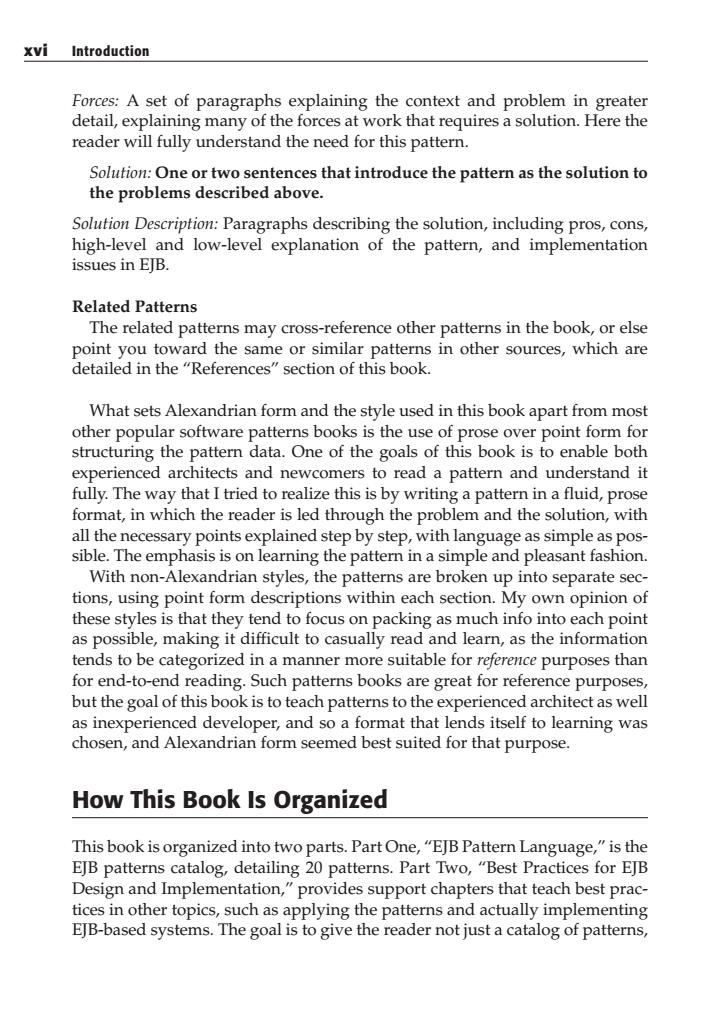正在加载图片...

xvi Introduction Forces:A set of paragraphs explaining the context and problem in greater detail,explaining many of the forces at work that requires a solution.Here the reader will fully understand the need for this pattern. Solution:One or two sentences that introduce the pattern as the solution to the problems described above. Solution Description:Paragraphs describing the solution,including pros,cons, high-level and low-level explanation of the pattern,and implementation issues in EJB. Related Patterns The related patterns may cross-reference other patterns in the book,or else point vou toward the same or similar patterns in other sources,which are detailed in the"References"section of this book. What sets Alexandrian form and the style used in this book apart from most other popular software patterns books is the structuring the pattem data.One of thegoo experienced architects and newcomers to read a pattern and understand it fully.The way that I tried to realize this is by writing a pattern in a fluid,pros format,in which the reader is led through the problem and the solution,with all the necessary points explained step by step,with language as simple as pos sible.The emphasis is on learning the pattern in a simple and pleasant fashion With non-Alexandrian styles,the patterns are broken up into separate sec- tions,using point form descriptions within each section.My own opinion of these styles is that they tend to focus on packing as much info into each point as possible,making it difficult to casually read and learn,as the information tends to be categorized in a manner more suitable for reference purposes than for end-to-end reading.Such patterns books are great for reference purposes but the goal of this book is to teach patterns to the experienced architect as well as inexperienced developer,and soa format that lends itself to learning was chosen,and Alexandrian form seemed best suited for that purpose. How This Book Is Organized This book is organized into twoparts.Part One,"EJB Pattern Language,"is the EJB patterns catalog,detailing 20 patterns.Part Two,"Best Practices for EJB Design and Implementation,"provides support chapters that teach best prac tices in other topics,such as applying the patterns and actually implementing EJB-based systems.The goal is to give the reader not just a catalog of patterns,Forces: A set of paragraphs explaining the context and problem in greater detail, explaining many of the forces at work that requires a solution. Here the reader will fully understand the need for this pattern. Solution: One or two sentences that introduce the pattern as the solution to the problems described above. Solution Description: Paragraphs describing the solution, including pros, cons, high-level and low-level explanation of the pattern, and implementation issues in EJB. Related Patterns The related patterns may cross-reference other patterns in the book, or else point you toward the same or similar patterns in other sources, which are detailed in the “References” section of this book. What sets Alexandrian form and the style used in this book apart from most other popular software patterns books is the use of prose over point form for structuring the pattern data. One of the goals of this book is to enable both experienced architects and newcomers to read a pattern and understand it fully. The way that I tried to realize this is by writing a pattern in a fluid, prose format, in which the reader is led through the problem and the solution, with all the necessary points explained step by step, with language as simple as possible. The emphasis is on learning the pattern in a simple and pleasant fashion. With non-Alexandrian styles, the patterns are broken up into separate sections, using point form descriptions within each section. My own opinion of these styles is that they tend to focus on packing as much info into each point as possible, making it difficult to casually read and learn, as the information tends to be categorized in a manner more suitable for reference purposes than for end-to-end reading. Such patterns books are great for reference purposes, but the goal of this book is to teach patterns to the experienced architect as well as inexperienced developer, and so a format that lends itself to learning was chosen, and Alexandrian form seemed best suited for that purpose. How This Book Is Organized This book is organized into two parts. Part One, “EJB Pattern Language,” is the EJB patterns catalog, detailing 20 patterns. Part Two, “Best Practices for EJB Design and Implementation,” provides support chapters that teach best practices in other topics, such as applying the patterns and actually implementing EJB-based systems. The goal is to give the reader not just a catalog of patterns, xvi Introduction